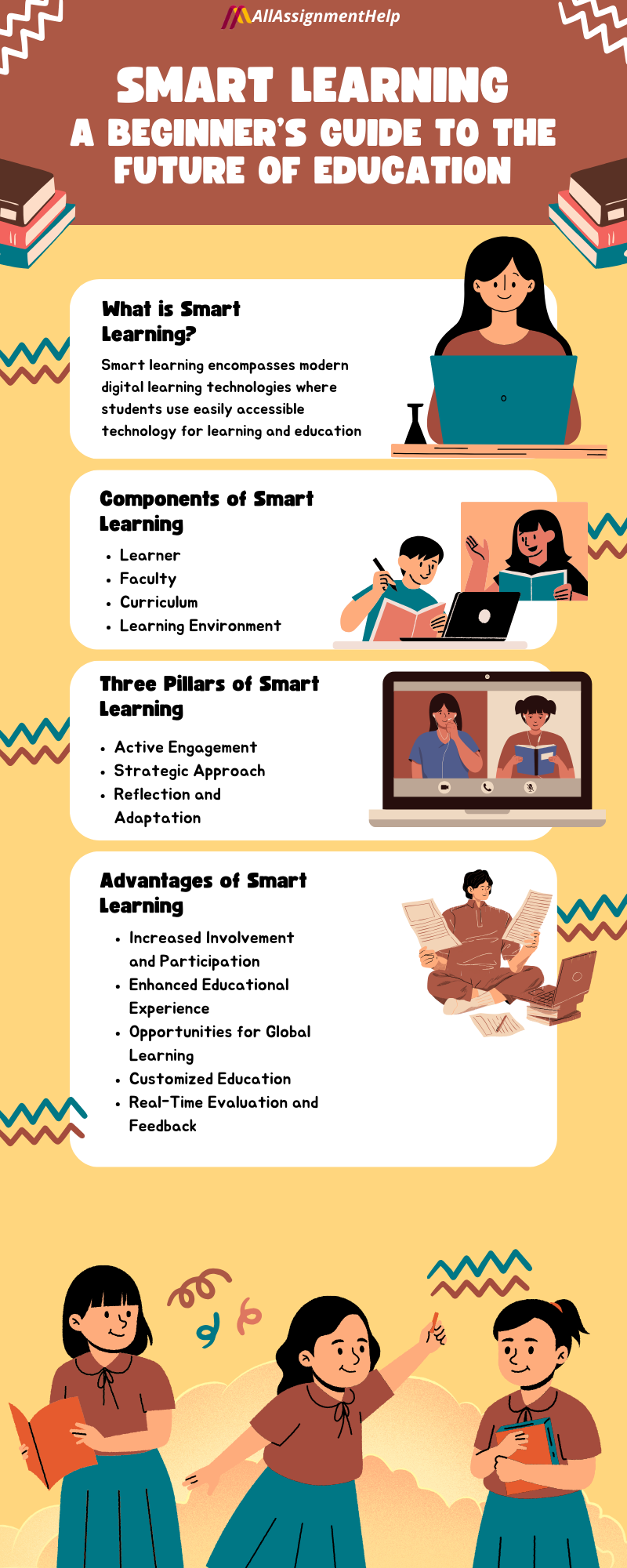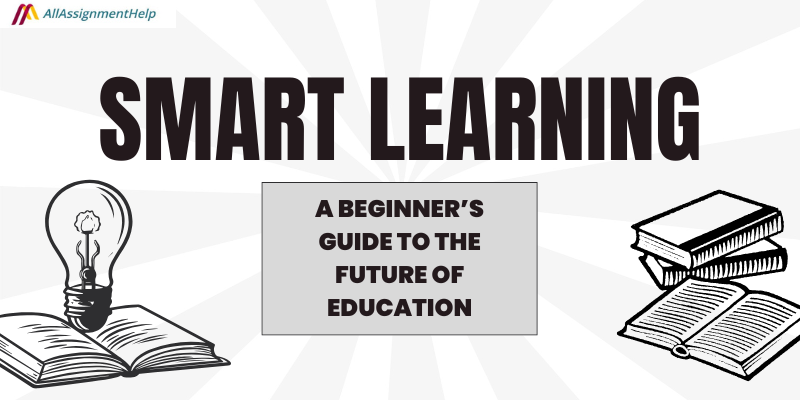Table of Contents
Education and smart learning are synonymous terms. Online education trends make education easier, quicker, and more efficient, particularly when learning complex subjects. This global trend is going to transform the way individuals acquire new knowledge and skills.
Imagine devoting hours to challenging, in-depth research to understand one fundamental concept. On the other hand, think about learning the same subject through a quick video clip. This will not only save you time but will also help students understand the concept of eLearning tools. However, we know that you might not be aware of the smart learning concept completely. This is where All Assignment Help experts have given you a detailed guide to let you know all the nuances of smart learning and its advantages.
What is Smart Learning?
Smart learning, often known as intelligent education, encompasses modern digital learning technologies where students use easily accessible technology for learning and education. It facilitates the learning of fresh information and skills more quickly, easily, and efficiently.
It uses a learner-centric approach, which implies an evolutionary shift in education. In contrast to traditional learning, smart learning uses immersive learning experiences and customized content to modify the teaching methodology to fit each student’s unique learning preferences.
However, students who are new to this type of learning might face problems at the start. They might face problems while working on their assignments and other tasks assigned by their professor. Don’t worry! Online assignment help services are always available to help students complete their assignments as per the smart learning criteria.
Read Here: How Education Technology is Facilitating the Learning Experience of Students

Components of Smart Learning
We cannot neglect the fact that smart learning is the future of education. Smart education makes use of technology to strengthen the learning process and make it more effective, interesting, and personalized for students. This involves the four major components, which include the following:
Learner
A learner is sometimes referred to as a student or someone who seeks knowledge. Smart education involves the student taking charge of the learning process instead of being a passive student who follows instructions.
Faculty
The faculty is the group of educators who are in charge of guiding the learning process. Faculty members serve as mentors or facilitators in smart learning. Moreover, they encourage students to seek information using eLearning tools within a learner-centered framework.
Curriculum
The curriculum refers to the subject matter of education. It shows how the structure and distribution of knowledge have changed over time in a savvy learning strategy.
Learning Environment
The learning environment is the setting in which learning takes place whether it be online or offline. Nowadays, mobile learning environments and digital learning technologies are common in smart learning. It enables students to learn at any time and from any location.
This kind of learning makes it simple and convenient for students to gain information and knowledge easily. Furthermore, smart learning facilitates online learning. It brings comfort and flexibility for students and allows them to enroll in online classes. However, online classes have their challenges which sometimes make them search on the Internet, where can I pay someone to take my online class for me? Don’t worry! There are services available that are ready to help you overcome the problems you face during your online classes and help you successfully complete your online coursework timely.
The Three Pillars of Smart Learning
The three important pillars that enable smart learning are:
Active Engagement
Active engagement guarantees that students are actively involved in the learning process rather than just passively absorbing information.
Key Practices Include:
- Take notes in your own words.
- Ask questions and seek answers.
- Discuss concepts with peers or mentors.
- Use techniques like self-quizzing or the Feynman technique.
Strategic Approach
An organized plan helps in concentrating efforts where they are most needed.
Key Practices Include:
- Set SMART goals (Specific, Measurable, Achievable, Relevant, Time-bound).
- Use tools like mind maps, and flashcards.
- Prioritize tasks using techniques like the Eisenhower Matrix or Pomodoro Technique.
Reflection and Adaptation
You can achieve continuous improvement by assessing and modifying your strategies over time.
Key Practices Include:
- Reflect on what works and what doesn’t (e.g., maintaining a learning journal).
- Seek feedback from others.
- Experiment with different study techniques, like active recall, interleaving, or peer learning.
Smart learning offers individualized, interesting, and effective learning experiences. It is transforming contemporary classrooms.
Advantages of Smart Learning You Must Know
eLearning tools can be beneficial when it comes to learning. Moreover, teachers can convert long paragraphs or phrases into interactive movies, graphs, flowcharts, and visualizations to help students better grasp a concept. A few advantages of smart learning include the following:
Increased Involvement and Participation
Students can take part in their education in dynamic and engaging ways with the use of resources such as interactive simulations, digital tests, and gamified learning platforms. Now, students can learn more interactively by adding attractive components that keep them actively involved. Also, this active participation makes lessons more enjoyable and less boring.
Enhanced Educational Experience
Advanced students require advanced solutions. Schools that choose smart learning could provide their students with a better experience by offering them individualized, safe, and easy platforms such as:
- Effective admissions procedure
- Systematic examination procedure
- Biometric tracking of attendance
- Smart teaching and learning resources
Furthermore, a better and more inspiring environment for students can be created by carrying out all academic and administrative tasks effectively and efficiently.
Opportunities for Global Learning
With smart learning, geographical limitations are no longer a barrier to education. Now, online classes, webinars, and virtual classrooms are accessible to students worldwide. Also, students taking different courses can get assignment help services for completing their academic writing tasks. For example, if someone is facing problems in writing their nursing assignments can easily get nursing assignment help online from experts. This makes it possible for students to collaborate with experts and study globally.
Customized Education
Smart learning has made it possible for students to focus on subjects they find challenging and study at their own pace. Additionally, teachers can modify their lessons to meet the specific needs of each student by creating a more effective learning environment. According to a National Education Association report, technology can help students learn more individually. More specifically, customized education has been associated with improved motivation and engagement, as well as improved grades and exam scores.
Real-Time Evaluation and Feedback
Real-time evaluations are an essential component of intelligent learning. Teachers can rapidly evaluate student performance using digital tools and provide feedback as needed. This instant prompt assists students in fixing errors and strengthening their learning without any delay. Also, this feedback is helpful to parents as it allows them to rapidly assess the performance of their child in many different areas. This makes it possible for them to offer prompt assistance and step in when required.
Smart learning will play a bigger role in education as technology develops to better educate future generations for success in a rapidly changing world.
Also Read: Top 10 Online Learning Platforms for 2024
Final Thoughts!
Smart learning is the best approach to ensure that higher education has the best future possible. The majority of universities use conventional methods to connect with more students. In the upcoming years, this tendency is expected to continue to gain speed. However, smart learning helps individuals see the potential of education which crosses national boundaries. Those who are passionate about reaching their highest potential can find their way in a smart new world.
About Us
All Assignment Help is among the top assignment writing services that provide excellent and reasonably priced assignment help services to students. Here, you can get online law assignment help, chemistry assignment help, finance assignment help, or help with any subject and its related assignment. With years of experience and writing expertise, our skilled subject matter experts can quickly finish your challenging assignments by the deadline. Moreover, we offer online support around-the-clock and more than 3,000 PhD experts are on board to assist with any assignment you need help with.
FAQs
| How does smart learning differ from traditional learning? Unlike traditional learning, which relies on fixed curriculums and classroom-based teaching, smart learning leverages digital tools and adaptive methods. It focuses on flexibility, real-time feedback, and personalized learning paths to cater to individual needs. |
| What is the role of artificial intelligence in smart learning? AI enables personalized learning by analyzing a student’s performance and tailoring content accordingly. It provides real-time feedback, and predictive analytics, and makes the learning process more efficient and targeted. |
| What is the future of smart learning? The future of smart learning includes advancements in AI, immersive experiences with AR/VR, adaptive learning algorithms, and integration with emerging technologies like blockchain for credentialing and secure data management. |
